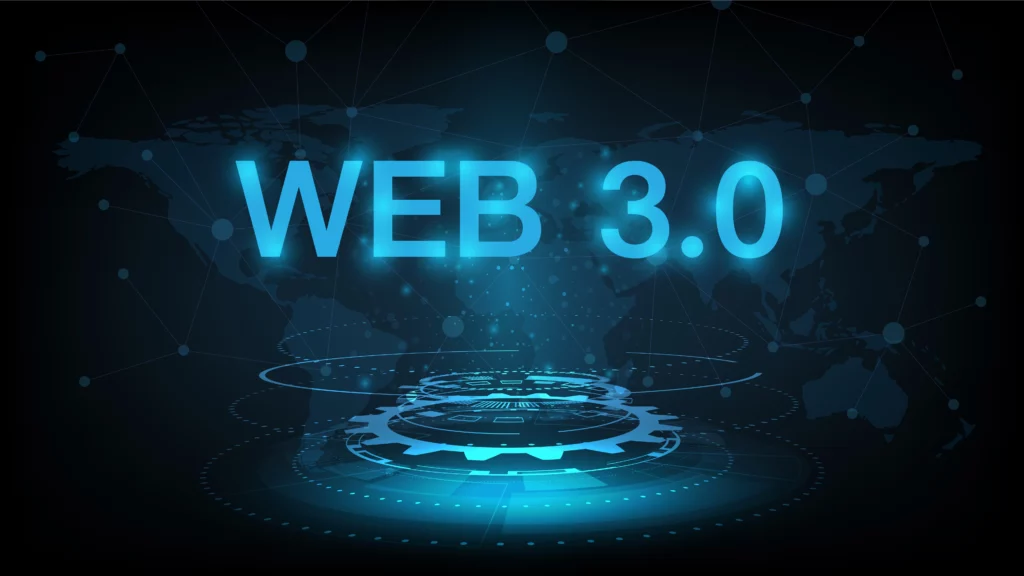Every futuristic imagination depicted in sci-fi movies is being made possible by the dexterity of the human mind.
“Web3 Technology”, also known as “Web 3.0”, is another milestone in this path.
Web3 using the advanced features of AI/ML, blockchain, and metaverse, is going to be a household technology in the nearest future. Although still in its infancy, Web3 is yet to get its stronghold on the grounds of the “Internet 3.0” infrastructure.
We will learn all we need to know about Web3 to become tech-ready for its upcoming daunting uses in our daily lives.
Key Takeaways
- Learn the Meaning of Web3 Technology.
- Understand the Working of Web3 Technology.
- Know About the History of Web1 and Web2 Technology.
- Difference between Web1, Web2, and Web3
- Importance of Web3 Technology
What is Web3 Technology

Web3, the third version of the World Wide Web (WWW), is going under development processes from 2006 and onwards.
It is a decentralised network of websites that integrates the semantic web with ML, AI, and 5G technologies in a metaverse platform and is secured by the blockchain system.
The cherry on the cake is that the user’s big data is owned by everyone and not concentrated with a few organizations or institutions. Its goal is to establish fast and interactive communication channels with real-world solutions for people.
7 Examples of Web3 technologies’ applications
- Siri: Apple’s virtual assistant.
- Meta Horizons: Horizon Worlds (VR gaming), Horizon Venues (Live virtual concerts), and Horizon Workrooms (virtual 3D workplaces), Oculus Quest headset of Mark Zukerberg’s Meta Inc.
- Ethlance: An Ethereum blockchain-based job market platform, connecting freelancers with employers.
- Decentraland: A multipurpose metaverse platform for creating art, gaming, organising events, buying and selling land virtually, and many more.
- Roblox: A famous gaming platform of Roblox Corporation.
- Storj: An open-source secure cloud object storage platform based on Ethereum cryptocurrency. It is decentralised and end-to-end encrypted, which makes it super secure.
- Everledger: A transparency solutions-based technology that aims to increase transparency in supply chains.
Looks fascinating! Right?
Well, the beauty of Web3 lies in the way it works. Let us know more about it.
How does Web3 Technology Work?
Let us understand the working of Web3 using the role of each concept involved in its processes:
1. Edge Computing:
Rather than storing user data in data centres and cloud databases, the big data will be allocated near the user ends, like phones or user-cloud storage.
2. Blockchain:
A peer-to-peer decentralised network which can’t be modified by a few individuals and control will not be managed by a few institutions and organisations.
3. Metaverse:
This immersive technology, already launched by giants like Adidas, Facebook’s Meta, Roblox, etc., is going to skyrocket in the business world in the next few years. Facilitated by AR, VR, blockchain, and cryptocurrencies, it has made 3D virtual worlds interactive, real-time, and lively for industries like advertising, gaming, tourism, meetings, training, and so on.
4. Semantic Web:
In Web3, the webpages will be properly mapped, processed, and tagged to allow the computers to assess and read them directly. This will allow users to attain more precise and effective content with exact meanings.
5. AI and ML:
AI-based computing networks on Web3, with their capabilities of deep learning and neural networks, will give users faster, relevant and predictive results, which will help them in decision-making.
5. 5G:
With very low latency, 100 times faster than 4G, and wider coverage, it is opening avenues for vast applications of Web3 in healthcare, gaming, e-commerce, and many more.
6. Cryptocurrencies:
Buying, selling, and money transactions without intermediaries or mediator banks using cryptocurrencies will be made possible.
Must Read: Limitations of Artificial Intelligence
History of Web1, Web2 and Web3 Technology
Web 1.0
Tim Berners-Lee, the CERN scientist, created WWW in 1989, He would never have imagined how advanced this technology could be.
Web1 used HTML, HTTP and URLs to create websites. Without search engines, the content was read-only for users, considering Urls are known.
In the 1990s, Netscape Navigator, the pioneering web browser, eased browsing for users.
Web 2.0
Web2, first mentioned in the article “Fragmented Future” by Darcy DiNucci in 1999, later became a reality in 2004. People could share content via social media platforms, blogs, discussion forums, and so on. Information became interactive and user-friendly.
Cloud-based operations emerged in the form of storing users’ big data, personalised suggestions on Amazon or Instagram, SaaS-based online applications, real-time apps like Uber, Ola, and Zomato, and many more.
Web 3.0
Web3 emerged in the background of multiple user complaints arising around Web2. For example,
- The concentration of data and services with few tech behemoths and government institutions.
- Breach of user privacy.
- Misuse of user-generated data.
- Spread of misinformation and hate-mongering via social media platforms.
- Unethical use of AI, and so on.
Difference between Web1, Web2 and Web3
Metaphorically, if the internet is the root, trunk and branch of a tree, then the Web is like leaves, i.e. the network of webpages connected via the internet.
In this analogy, Web1 is like a showpiece tree; you see, which was already designed by someone. So, in Web1, you can only read what is published on websites.
Web2 is like a tree on private property. You can see it, but you can also plant your own tree in your own space. Likewise, in Web2, you can read, comment, download, upload, and write your own content on websites.
On the other hand, Web3 is like trees in a public place. All the people using the space are answerable for growth and damage to these trees. In the same way, in Web3, you can read, write, buy and sell through cryptocurrencies and interact with data in the 3D metaverse.
Importance of Web3 Technology

The top 8 features of Web3 are as follows:
- Data Accessibility: Dismantling the supremacy of a few tech giants, blockchain, and edge computing has made data accessible to all users, establishing true informational democracy.
- Interoperability: Users could freely and easily switch between various platforms, websites and applications.
- Data privacy and security: Data will become hard to breach, hack, or misuse.
- Incredible usability: Web3 wallets and applications will make possible more dynamic, life-like and personalised interactions faster and more advanced browser search assistance by AI and deep learning.
- Transparency: Removing the role of intermediaries, will directly connect the user and service providers.
- Scalability: Web3 will be put to use in a vast number of applications for a large number of people at the same time.
- Time-saving: 3D interactions will reduce the leg-work for meetings, travel and tourism, shopping with a trial, partying, and so on.
- Information Greening: Data can’t get edited or manipulated and thus will always be present in the Web3, which is a pro as well as a con, as it snatches away RTBF (The Right to be forgotten) from you.
Conclusion
The rampant use of Web3 in every individual’s hands is just around the corner, with its daunting features. But the archaic challenges of network security, financial inequalities, and AI machines becoming uncontrollable are still valid.
Careful stewardship, prudent contribution, and synergy among all stakeholders in helping build the safe and secure development of Web3 are crucial.
I am sensing excitement and hope in you. Hopefully, we all will make fair and sustainable use of this technology in the upliftment of humanity.
Frequently Asked Questions (FAQs)
People Also Ask
What is Web3 used for?
Web3 has a vast number of applications, some of them are:
1. In the healthcare industry: for developing tele-assistants to take over the menial works of a doctor.
2. In the gaming industry: to develop 3D ultra-high interactive games.
3. In e-Commerce: in developing websites that can use metaverse, cryptos and blockchain to establish e-commerce platforms.
Is Web3 a blockchain technology?
Web3 is definitely a technology that utilises blockchain to develop a peer-to-peer-based decentralised network.
Is Web3 the same as metaverse?
Web3 is not the same as metaverse but uses the metaverse technology to create high-performance Web3-based websites and application solutions for consumers.




Hi there, all the time i used to check weblog posts here early in the break of day,
because i like to learn more and more.
I know this website gives quality based articles or reviews and
other stuff, is there any other site which
offers such things in quality?